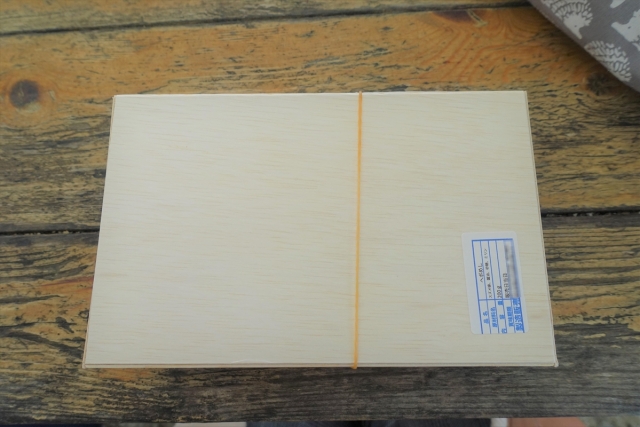
A local specialty best eaten with a side of courage.
Our Japanese-language reporter Haruka Takagi was travelling through central Japan recently when she came across an unusual sign at a roadside rest stop that read: “Hebomeshi Wasp Larva Rice“.
ヘボ, or “hebo”, refers to the larva of Vespula flaviceps, a wasp that kind of looks like the infamous murder hornet, but is slightly smaller and less dangerous, while めし, or “meshi” means “rice”, often a rice that has ingredients mixed through it.
Haruka had heard about this local delicacy during her travels, where locals had insisted she try it if she had the chance. Well, this was her chance, so she decided to take it, handing over 800 yen (US$7.03) to the kind saleslady, who presented her with this bento box containing her meal.
From what Haruka had been told, hebomeshi is a local dish that’s been handed down through generations in the mountainous areas of Nagano, Gifu and Aichi prefectures. The reason why there’s a culture of eating hebo here is because it’s a valuable protein source in the mountains.
According to the Ministry of Education, Culture, Sports, Science and Technology, wasps are said to contain 16.2 grams (0.57 ounces) of protein per 100 grams, which is similar to mackerel (16.3 grams) and pork hearts (16.2 grams).
▼ Looking at the back of the bento box revealed the ingredients inside: wasps, soy sauce, sugar, mirin.
These are ingredients you don’t usually find in an everyday lunchbox, and if the sound of them makes you feel squeamish, it’s best you look away now, because things are going to become a whole lot visual…
.
.
.
.
.
…are you ready???
.
.
.
.
▼ Ta daaa!
Leaning in to take a closer look at the meal, Haruka found there were a LOT more insects in here than she’d expected.
Swearing to avoid making any biased judgments, Haruka held back her desire to scream and turn her head away. This was a local specialty, and a nutritional feast that’s sustained Japanese mountain dwellers for generations, so she was determined to eat the whole thing.
▼ It didn’t just contain larvae but adult wasps too.
▼ Haruka placed her hands together and said a nervous “itadakimasu!”
Keeping her eyes off the rice for her first bite, she found that it tasted…surprisingly delicious. The soy sauce and mirin in the rice imparted a light, sweet flavour to the meal, while the larvae popped and the adult wasps crunched between her teeth.
If she were to compare the insects to anything, she’d say that the larvae had a thick, creamy taste, similar to say, salmon roe. The adult wasps, on the other hand, were similar to prawns.
Thankfully, there was no bitter, insect-like flavour here, and if you can get over the look of insects in your rice, it’s actually a really tasty meal.
▼ The face of a woman confused by equal measures of deliciousness and discomfort in her brain.
Aside from the insects, one thing that perturbed Haruka the most was the fact that she was eating this bento cold. She couldn’t help but think it would taste even better warmed up, and so she took the meal home with her and popped it into the microwave for dinner.
This was much, much better. The heat helped to warm and soften the skin of the larvae, making them taste even less insect-like. The rice was also more plump and flavourful, and if you were to eat it blind, you wouldn’t even know you were eating insects.
▼ Keeping your eyes away from the rice helps to dull that part of your brain telling you not to eat it.
Haruka had never tried hebomeshi before, so she’s glad she was able to try it once to further her culinary knowledge of Japan. Whether she’ll try it again, well, that’s unlikely. She’d much rather return to eating sweet bean toilets and leave the insect-eating to our other reporters.
Photos ©SoraNews24
● Want to hear about SoraNews24’s latest articles as soon as they’re published? Follow us on Facebook and Twitter!
[ Read in Japanese ]

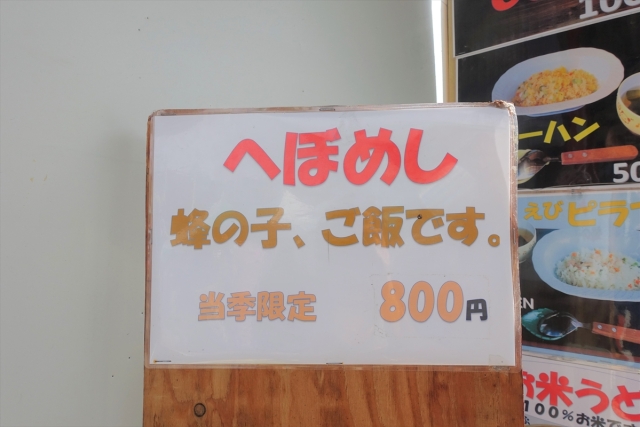
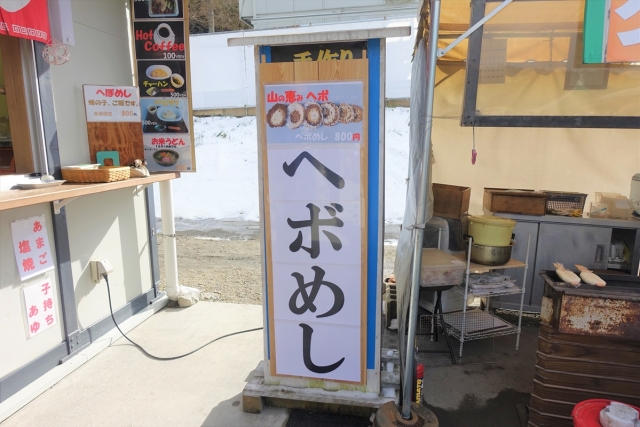
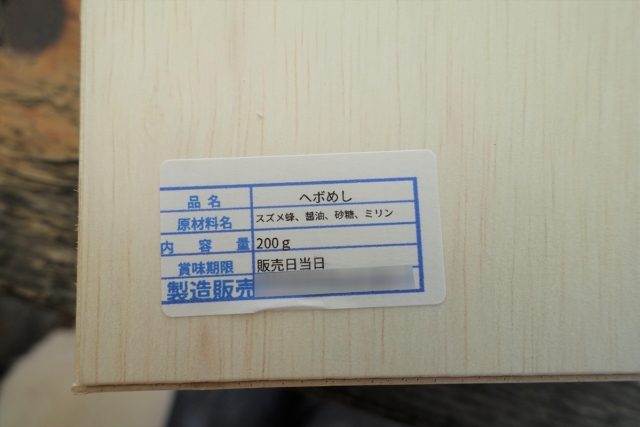

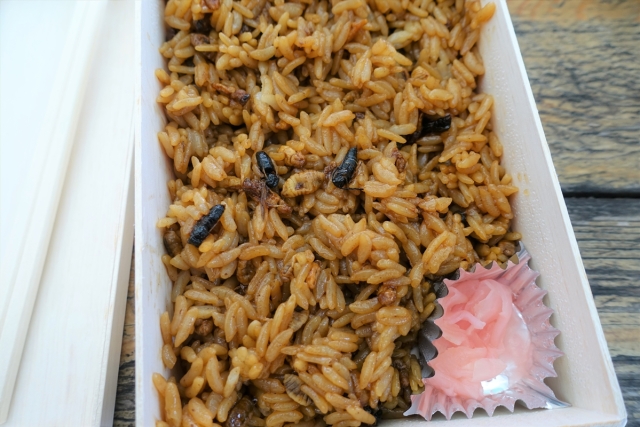

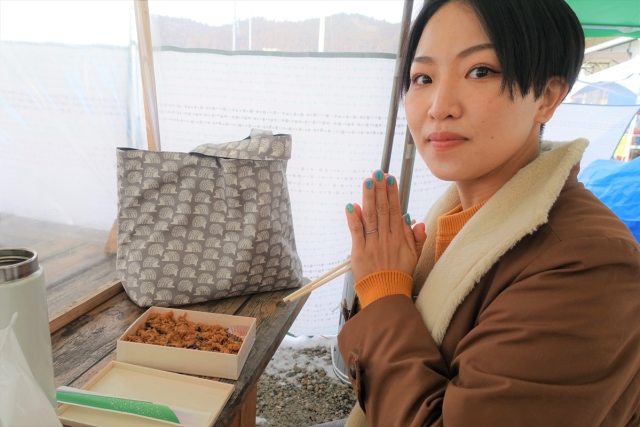
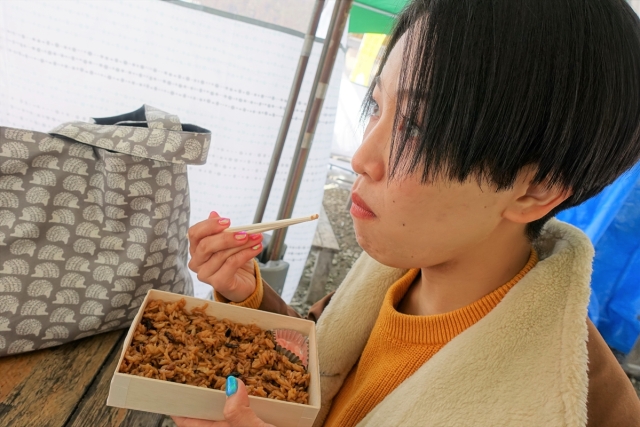
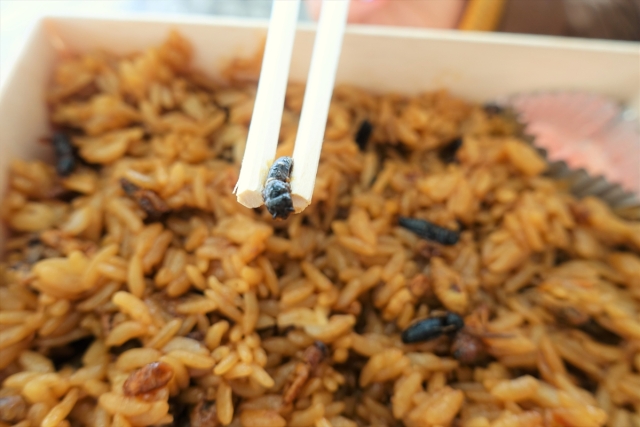
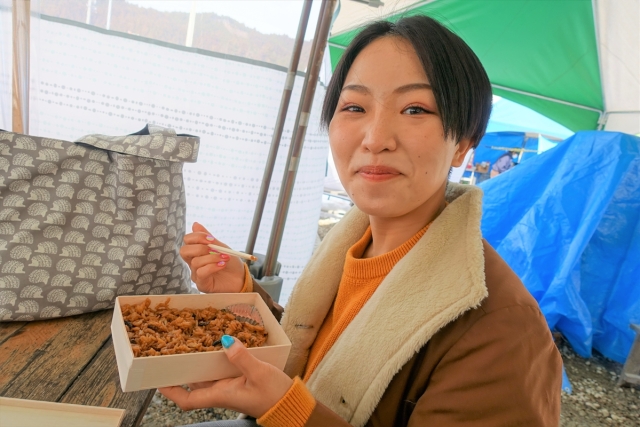
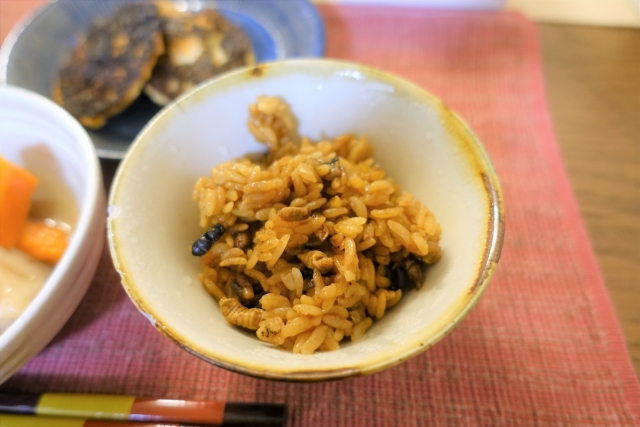
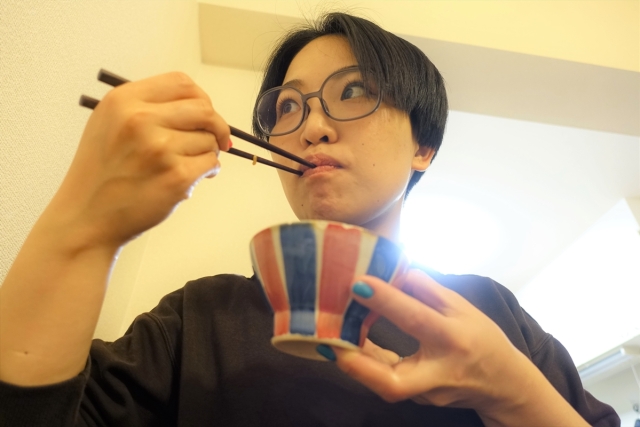
 Japanese wasp-filled crackers: Their sting is far worse than a bite
Japanese wasp-filled crackers: Their sting is far worse than a bite A visit to Japan’s wasp nest art museum stings us with respect for the industrious insects【Pics】
A visit to Japan’s wasp nest art museum stings us with respect for the industrious insects【Pics】 We try eating insects — they don’t taste like chicken
We try eating insects — they don’t taste like chicken Vending machine noodle ice cream: A retro icon in Japan brings joy to a new generation
Vending machine noodle ice cream: A retro icon in Japan brings joy to a new generation Weird Japanese vending machine find gives us unique sweet potato sweets
Weird Japanese vending machine find gives us unique sweet potato sweets Disney princesses get official manga makeovers for Manga Princess Cafe opening in Tokyo
Disney princesses get official manga makeovers for Manga Princess Cafe opening in Tokyo Beautiful new Final Fantasy T-shirt collection on the way from Uniqlo【Photos】
Beautiful new Final Fantasy T-shirt collection on the way from Uniqlo【Photos】 Randomly running into a great sushi lunch like this is one of the best things about eating in Tokyo
Randomly running into a great sushi lunch like this is one of the best things about eating in Tokyo Is the new Shinkansen Train Desk ticket worth it?
Is the new Shinkansen Train Desk ticket worth it? Hey, Japanese taxi driver! Take us to your favorite restaurant in Tsuruga City!
Hey, Japanese taxi driver! Take us to your favorite restaurant in Tsuruga City! Osaka’s creepy cute mascot speaks for first time, adds more fuel the creepy OR cute debate【Video】
Osaka’s creepy cute mascot speaks for first time, adds more fuel the creepy OR cute debate【Video】 What’s wrong with English education in Japan? Pull up a chair…
What’s wrong with English education in Japan? Pull up a chair… Kyushu-exclusive Black Mont Blanc goes nationwide in a “Special” way
Kyushu-exclusive Black Mont Blanc goes nationwide in a “Special” way How to make an epic pizza at a Japanese family restaurant
How to make an epic pizza at a Japanese family restaurant Hanton rice — a delicious regional food even most Japanese people don’t know about, but more should
Hanton rice — a delicious regional food even most Japanese people don’t know about, but more should We try out “Chan Ramen”, an underground type of ramen popular in the ramen community
We try out “Chan Ramen”, an underground type of ramen popular in the ramen community New Studio Ghibli bedding sets are cool in all senses of the word
New Studio Ghibli bedding sets are cool in all senses of the word Our Japanese reporter visits Costco in the U.S., finds super American and very Japanese things
Our Japanese reporter visits Costco in the U.S., finds super American and very Japanese things Foreign English teachers in Japan pick their favorite Japanese-language phrases【Survey】
Foreign English teachers in Japan pick their favorite Japanese-language phrases【Survey】 New Pokémon cakes let you eat your way through Pikachu and all the Eevee evolutions
New Pokémon cakes let you eat your way through Pikachu and all the Eevee evolutions There’s a park inside Japan where you can also see Japan inside the park
There’s a park inside Japan where you can also see Japan inside the park Japanese convenience store packs a whole bento into an onigiri rice ball
Japanese convenience store packs a whole bento into an onigiri rice ball Final Fantasy, Kingdom Hearts, and Dragon Quest pet product line announced by Square Enix
Final Fantasy, Kingdom Hearts, and Dragon Quest pet product line announced by Square Enix Studio Ghibli releases Kiki’s Delivery Service chocolate cake pouches in Japan
Studio Ghibli releases Kiki’s Delivery Service chocolate cake pouches in Japan Japan’s bone-breaking and record-breaking roller coaster is permanently shutting down
Japan’s bone-breaking and record-breaking roller coaster is permanently shutting down New definition of “Japanese whiskey” goes into effect to prevent fakes from fooling overseas buyers
New definition of “Japanese whiskey” goes into effect to prevent fakes from fooling overseas buyers Foreign passenger shoves conductor on one of the last full runs for Japan’s Thunderbird train
Foreign passenger shoves conductor on one of the last full runs for Japan’s Thunderbird train Kyoto bans tourists from geisha alleys in Gion, with fines for those who don’t follow rules
Kyoto bans tourists from geisha alleys in Gion, with fines for those who don’t follow rules Studio Ghibli unveils Mother’s Day gift set that captures the love in My Neighbour Totoro
Studio Ghibli unveils Mother’s Day gift set that captures the love in My Neighbour Totoro Domino’s Japan now sells…pizza ears?
Domino’s Japan now sells…pizza ears? Toyota built a life-sized Miraidon Pokémon and are letting people test drive it this weekend
Toyota built a life-sized Miraidon Pokémon and are letting people test drive it this weekend New Japanese KitKat flavour stars Sanrio characters, including Hello Kitty
New Japanese KitKat flavour stars Sanrio characters, including Hello Kitty Sales of Japan’s most convenient train ticket/shopping payment cards suspended indefinitely
Sales of Japan’s most convenient train ticket/shopping payment cards suspended indefinitely Sold-out Studio Ghibli desktop humidifiers are back so Totoro can help you through the dry season
Sold-out Studio Ghibli desktop humidifiers are back so Totoro can help you through the dry season Japanese government to make first change to romanization spelling rules since the 1950s
Japanese government to make first change to romanization spelling rules since the 1950s Ghibli founders Toshio Suzuki and Hayao Miyazaki contribute to Japanese whisky Totoro label design
Ghibli founders Toshio Suzuki and Hayao Miyazaki contribute to Japanese whisky Totoro label design Doraemon found buried at sea as scene from 1993 anime becomes real life【Photos】
Doraemon found buried at sea as scene from 1993 anime becomes real life【Photos】 Tokyo’s most famous Starbucks is closed
Tokyo’s most famous Starbucks is closed One Piece characters’ nationalities revealed, but fans have mixed opinions
One Piece characters’ nationalities revealed, but fans have mixed opinions We asked a Uniqlo employee what four things we should buy and their suggestions didn’t disappoint
We asked a Uniqlo employee what four things we should buy and their suggestions didn’t disappoint Princesses, fruits, and blacksmiths: Study reveals the 30 most unusual family names in Japan
Princesses, fruits, and blacksmiths: Study reveals the 30 most unusual family names in Japan Studio Ghibli’s new desktop Howl’s Moving Castle will take your stationery on an adventure
Studio Ghibli’s new desktop Howl’s Moving Castle will take your stationery on an adventure We visit “Rice and Circus,” a restaurant that combines bugs and Japanese-style cooking【Photos】
We visit “Rice and Circus,” a restaurant that combines bugs and Japanese-style cooking【Photos】 Wasp and mealworm sushi on the (unusual) menu at the Tokyo Bug-Eating Festival 【Photos】
Wasp and mealworm sushi on the (unusual) menu at the Tokyo Bug-Eating Festival 【Photos】 We visit Kaiyodo Kappa Museum: dedicated to a yokai that loves cucumbers and human souls
We visit Kaiyodo Kappa Museum: dedicated to a yokai that loves cucumbers and human souls Puyo Puyo Manju return after 21 years…and our Puyo Puyo fan reporter achieves a childhood dream
Puyo Puyo Manju return after 21 years…and our Puyo Puyo fan reporter achieves a childhood dream The most expensive ice cream in Japan? Metallic soft serve frays the nerves of staff who make it
The most expensive ice cream in Japan? Metallic soft serve frays the nerves of staff who make it We hunt for Dom Pérignon in these wine fukubukuro lucky bag boxes from Kaldi
We hunt for Dom Pérignon in these wine fukubukuro lucky bag boxes from Kaldi Roses and cherry blossoms help to repel wasp attacks, according to Kochi University study
Roses and cherry blossoms help to repel wasp attacks, according to Kochi University study Do you know what this caterpillar-like food is? We had no idea!【Taste test】
Do you know what this caterpillar-like food is? We had no idea!【Taste test】 Give your loved ones stag beetle larvae and more this Valentine’s
Give your loved ones stag beetle larvae and more this Valentine’s Vending machine in Kumamoto to offer delicious insect snacks, let you munch them on the go
Vending machine in Kumamoto to offer delicious insect snacks, let you munch them on the go Weird Japanese vending machine comes with a heartwarming twist
Weird Japanese vending machine comes with a heartwarming twist This rare autumn vegetable is the perfect addition to your stir-fry or salad【SoraKitchen】
This rare autumn vegetable is the perfect addition to your stir-fry or salad【SoraKitchen】 We visit a train station in historical ninja town, see ninja trick art, and become ninjas ourselves
We visit a train station in historical ninja town, see ninja trick art, and become ninjas ourselves Making a traditional Japanese dessert from “heaven grass”【Photos】
Making a traditional Japanese dessert from “heaven grass”【Photos】 A tiny coffee stand in Japan is selling some of the most lifelike gummy bugs we’ve ever seen
A tiny coffee stand in Japan is selling some of the most lifelike gummy bugs we’ve ever seen Daiso vs. Seria: Which sells the better egg white whipper? We find out【SoraKitchen】
Daiso vs. Seria: Which sells the better egg white whipper? We find out【SoraKitchen】
Leave a Reply